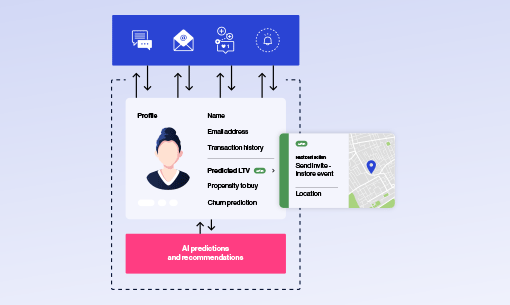AI decision making: the future of business intelligence
By Jon Taylor on August 23, 2021 - 10 Minute ReadData is the backbone of a modern business – it helps us make better decisions and learn more about our customers.
But with all this data comes a problem: how can our brains possibly process it all?
That’s where artificial intelligence (AI) decision making comes into play. AI decision making is where companies utilize AI in their processes to help make faster, more accurate, more consistent decisions by leveraging datasets with AI. Unlike humans, AI can analyze large datasets in seconds without errors, freeing up your team to focus on other work.
And businesses are catching on – 66% of decision makers say applications of AI, like machine learning, computer vision and natural language processing, are now helping them increase profits and reach their goals.
In this piece, we’re going to break down:
- What is AI decision making?
- How does AI help in decision making?
- Can artificial intelligence make decisions?
- Three types of AI that are changing the way businesses make decisions
Let’s get started ?
What is AI decision making?
AI decision making is when data processing – like analyzing trends and suggesting courses of action – is done either in part or completely by an AI platform instead of a human to quantify data in order to make more accurate predictions and decisions.
In theory, by handing over your data to an AI platform, tasks like data crunching, trend spotting, anomaly detection and complex analysis can be done by AI. The final decision is then made by a person or automated entirely, like so:
A decision making model that utilizes AI:

Making decisions this way simplifies the process drastically, but it cuts out humans completely (which isn’t always a great idea). This is why processes that combine humans and AI are now gaining momentum.
So, to say that AI decision making could be revolutionary for businesses is an understatement.
McKinsey predicts that by 2030, around 70% of businesses will be using at least one type of AI technology, and roughly half of all large companies will have a full range of AI tech embedded in their processes.
AI decision making has the power to increase the world’s economic output, and the estimates are huge: a possible boost of around $13 trillion to the world economy by 2030, which is an extra 1.2% of global GDP for those playing along at home.
For businesses, adding AI to workflows is expected to be more important than increased profits and revenues. Gartner says businesses are now being digitally disrupted by the sheer amount of data they have to deal with – and it could overwhelm them. But with the help of AI, it’s possible to turn all that data into tangible outcomes, from sales and marketing through to demand planning and supply chains.
The size, complexity, distributed nature of data, speed of action and the continuous intelligence required by digital business means that rigid and centralized architectures and tools break down. The continued survival of any business will depend upon an agile, data-centric architecture that responds to the constant rate of change.
Donald Feinberg
Vice President, Gartner
AI can help businesses make better decisions. So, how exactly does that work?
How does AI help in decision making?
AI is helpful for businesses because it has the unique ability to constantly teach itself – the more data-driven decisions it makes, the more it learns. AI trains itself and uses data collections to build models that become really, really good at making predictions and categorizations over this data. These same models can then be used on live data in real time to make predictions, categorizations and recommendations in real-time, allowing businesses to make great commercial decisions.
As an example, at Peak we use things like customer transaction data – taken from thousands upon thousands of purchases – to learn what products certain segments of customers are buying together. This model is then used to recommend complementary products on a website. If that seems familiar, it’s because other companies like Amazon take the same approach to make better recommendations to their customers to increase purchases.
This is remarkably different from how businesses have operated over the last 100, 50, or even 20 years ago. Because up until now, there was a central point where every important decision was made: a human.
Instead of relying on machines, humans analyzed data to decide everything from what customers to target, to which marketing campaigns were too risky, to how much a new product launch would cost. The issue with leaving every decision to a human is that we are…well, humans! Our emotions creep in, we get stressed, and our cognitive biases (there are over 180 of them) guide our decisions as much as the datasets do. Dr Jim Taylor, a psychology expert at the University of San Francisco, says that these cognitive biases are simply bad for business.
Cognitive biases are most problematic because they cause business people to make bad decisions. Only by filtering out the cognitive biases that are sure to arise while decisions are being made can you be confident that, at the end of the day, the best decision for you and your company was made based on the best available information.
Dr Jim Taylor
University of San Francisco
On paper, introducing AI into a business’ decision making process seems like a no-brainer:
- AI helps businesses make better decisions: Quickly analyzing large datasets allows businesses to make instant decisions, like what content they should create for their target audience or what they need to change up in a failing advertising campaign. This is incredibly time-consuming for humans, but for a machine, it’s instant
- It can boost sales and marketing campaigns: AI applications like Natural Language Processing help companies understand how their customers are interacting with their brand, what words they’re using and what tone they should strike to make them more appealing
- It helps businesses understand their customers better: AI tools like chatbots, algorithms and machine learning provide companies with a deeper understanding of their customers’ pain points, expectations and satisfaction levels
- It allows companies to make decisions that take into account huge amounts of complex data: AI is uniquely positioned to help make sense of vast quantities of data, particularly where a clearly defined outcome is measurable. For AI, decisions can look at all of this data instantly – people can’t
The problem is that while decision makers tend to trust AI, getting their teams bought into the idea – and reassuring them that it isn’t here to take their jobs! – isn’t always easy.
Studies suggest that this problem could stem from a lack of understanding and cultural differences about how helpful AI can be. 64% of decision makers say their team either doesn’t trust or understand AI-enabled recommendations, making it hard for their organization to take full advantage of the technology.
It’s important to understand, though, that it doesn’t have to be this black and white. It’s not a case of deciding who is going to make every decision in a business, machines or humans – they both have their strengths and they both have their weaknesses.
AI is great at dealing with noise and complexity, looking at data sets and spotting trends instantly. But humans are fantastic at understanding certain external factors and making more creative-led decisions. In most cases, the best solution is for AI and humans to work together.
Can AI make smarter decisions than humans?
Data – when it’s collected and analyzed correctly – can give decision makers deep, unparalleled insight into every part of a business.
The problem modern companies face is that they’re drowning in data. Humans can’t keep up. And with so much data being collected, it’s not surprising that processes like spreadsheets and databases just don’t cut it anymore.
So, businesses are left with a choice to make: do we keep humans in charge, or let the machines take over some of the data-driven decision making?
The reality is that humans are always going to be limited when it comes to making data-based decisions. Harvard Business Review says this is because:
- Humans don’t leverage all the data: We struggle to collate every aspect of a dataset, like insights, relationships and patterns. Humans tend to manage large amounts of data by summarizing it, and we physically can’t process millions (or billions) of records. Our minds simply struggle to link the relationships between data elements, which is key to good decision making
- Humans let our biases take over: We tend to prioritize data that we think is important, not what the data actually says. This is because humans tend to think of data as linear, and our brains can’t process aggregates like AI can. When a decision requires knowing the cities, ZIP codes and addresses of a thousand customers, humans may only be able to make a decision based on a regional level (e.g Northside of the city), whereas AI can easily aggregate the data needed and cut through the noise that may otherwise cloud a human’s judgment
And the reality is that AI doesn’t have feelings: it can make decisions and collate data without letting emotion, bias or human error get in the way. And, as crazy as it might sound, AI can now beat us at everything from video games to image recognition to lip reading.
If bold and science fiction-sounding statements are your thing, you may be interested to know that some are now predicting that AI will overtake humans in everything by 2060. Over the next several years, many believe that AI will become better than us at things like translating, writing essays and even driving and performing surgeries.
So, we’re no longer needed, right? Wrong!
Will AI eliminate the need for human decision making? Not so fast!
Just because AI can collate data quicker than humans and analyze it more easily doesn’t mean that leaving everything up to machines is a smart business move.
In reality, successful companies will always need that human touch. There are thousands of ways people can influence decision making for the better, whether it’s with killer marketing copy, a bold and adventurous advertising strategy or by making compassionate customer service decisions.
Here’s an example. Imagine that you’re running a warehouse and your AI decision making process tells you that by cutting down on the amount of stock you keep, the company can save money on storage costs.
On paper, this makes perfect sense. But to a team leader who knows that the extra stock allows the company to fulfill company orders without risking their supply chain – and keep customers happy with quick shipments – the extra storage costs are worth it.
This type of decision making is different from the earlier example we looked at, where AI is in control. Here, human judgement overrides the decision made by AI:
A decision making model that combines the power of AI and human judgment:

And there’s still a place for this type of decision making in modern businesses.
Three types of AI that are changing the way businesses make decisions
Simple: Amazon’s Flywheel
Amazon is worth over $1 trillion, and over 35% of the company’s revenues are generated using AI.
The company uses an AI-based product recommendation engine, commonly referred to as a flywheel, to make sure it’s constantly innovating. Founder Jeff Bezos sketched out the idea on a napkin – long before AI helped shape the company:

(Source: FPT TechInsight)
Now, several datasets from three popular Amazon products – Amazon Go Store, Alexa and the store’s recommendation engine – keep the flywheel turning. And the reason it works is remarkably simple: by reducing costs, the company increases customer visits, which in turn increases sales and leads to more sellers joining the platform.
AI is a big part of the flywheel because it focuses on keeping customers around.
For example, if a customer asks Alexa to look up a musical artist, it can then later recommend music purchases through Amazon Music. The next time the customer logs into their Amazon Prime account, they may be shown vinyl or streaming options to buy based on their previous music requests.
By storing and analyzing every piece of data using AI, Amazon can deliver a totally personalized, cohesive experience to each of its customers.
Safety: Volvo’s AI-driven sensors
Roughly 1.3 million people die every year in road accidents, and Volvo is leaning on AI to help change that.
Earlier this year, the car company launched a fleet of electric vehicles with AI-driven super computers embedded in them. The machines are connected to sensors that will help detect and analyze driving conditions as well as monitor the car’s performance in real-time to flag any dangerous conditions.
The cars are one of the first examples of relying on AI instead of human decision making to reduce accidents. In the past, safety technology in cars was mostly based on warning the driver about any threats near them. Volvo’s new tech means AI will intervene immediately when it sees a risk, which it hopes will save lives and reduce injuries.

(Volvo’s AI sensors cover the entire area around a customer’s car to help reduce accidents. Source: Volvo)
Volvo also collects the data from each customer’s car and stores it in their cloud. The company plans to use machine learning analysis to automatically spot patterns and predict failures and breakdowns in its vehicles.
Surviving COVID-19: PrettyLittleThing’s customer pivot
When COVID-19 shut down the retail industry in early 2020, fashion and lifestyle brand PrettyLittleThing had to pivot quickly to break into the US e-commerce market.
The company knew that it needed to reach customers that hadn’t shopped with them before, which required taking a data-driven approach. Above all else, the brand wanted to achieve one goal: make their new customers’ experiences as personalized as possible.

So, the brand turned to us at Peak to help.
First, we used our AI platform and Customer Intelligence applications to see what an ideal PrettyLittleThing customer looked like in the US. We then used this to identify potential high-value customers and forecast their product preferences as well as potential average order values and purchase frequency.
This gave PrettyLittleThing the data they needed to create a targeted approach to the saturated US e-commerce market and made sure they were only advertising to potential customers. The brand then launched a weekend customer acquisition campaign to boost on-site sessions and clickthrough rates.
The campaign was so successful that it’s still running.
In such a competitive and fast-paced sector, this data-driven view of our customer base will be pivotal to our success as we look to continue our rapid growth and expansion. We look forward to introducing AI into other aspects of our marketing over the coming months.
Matt Holmes
Head of Digital Marketing, PrettyLittleThing
Are you ready to take advantage of AI decision making?
Modern business owners are dealing with a lot of moving parts every day, from remote work to new technologies.
The last thing business owners have time for is to spend hours (and hours) trying to analyze every row, column or cell of data to make decisions.
Thanks to AI decision making, business owners can now solve two problems at once. Mass datasets can be analyzed instantly, and cognitive biases can be removed from the process entirely so that every decision is made using cold, hard facts.
The only risk for business owners now is if they don’t take advantage of AI technology. More businesses are integrating AI into their tech stacks, making them more competitive with how targeted their marketing is, how accurately they can forecast future demand and how quickly they can pivot when problems arise.
So what are you waiting for – are you ready to start using AI to make decisions?

AI for inventory: right stock, right place, right time
Discover the true power of AI decision making
We'd love to talk to you about how Peak can help you adopt game-changing AI.
Businesses today are using game-changing AI to win.
Explore the resources below and get more familiar with commercial AI.

Headless Segmentation: The only way to win with your customers



